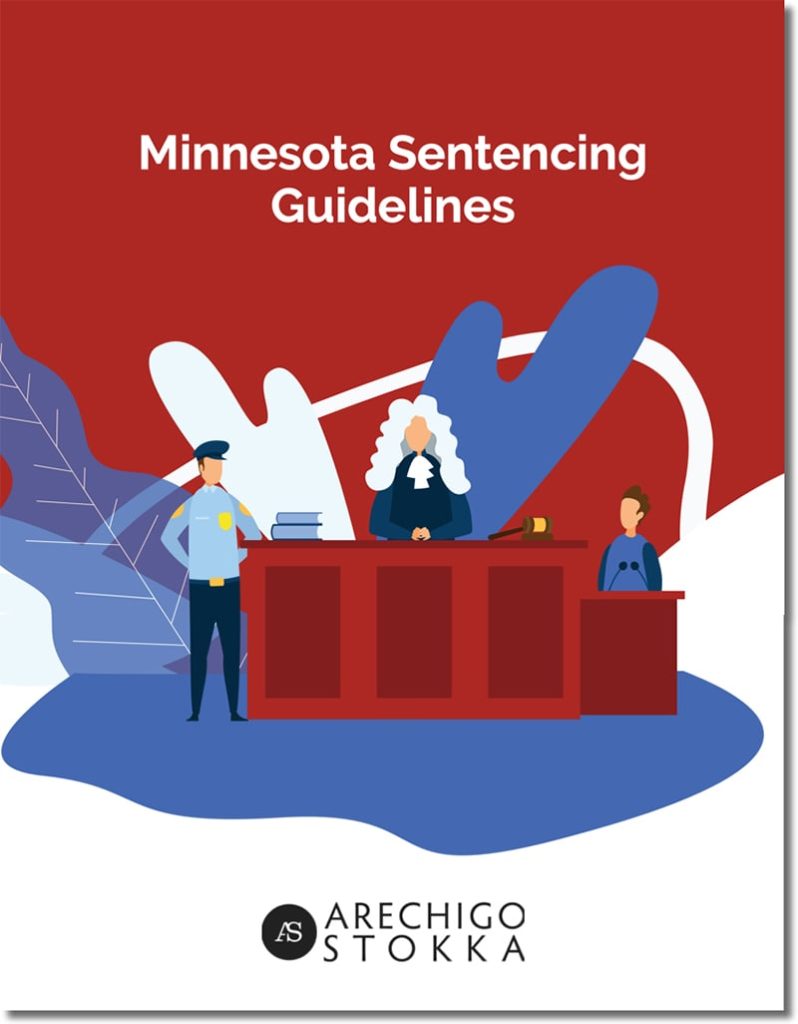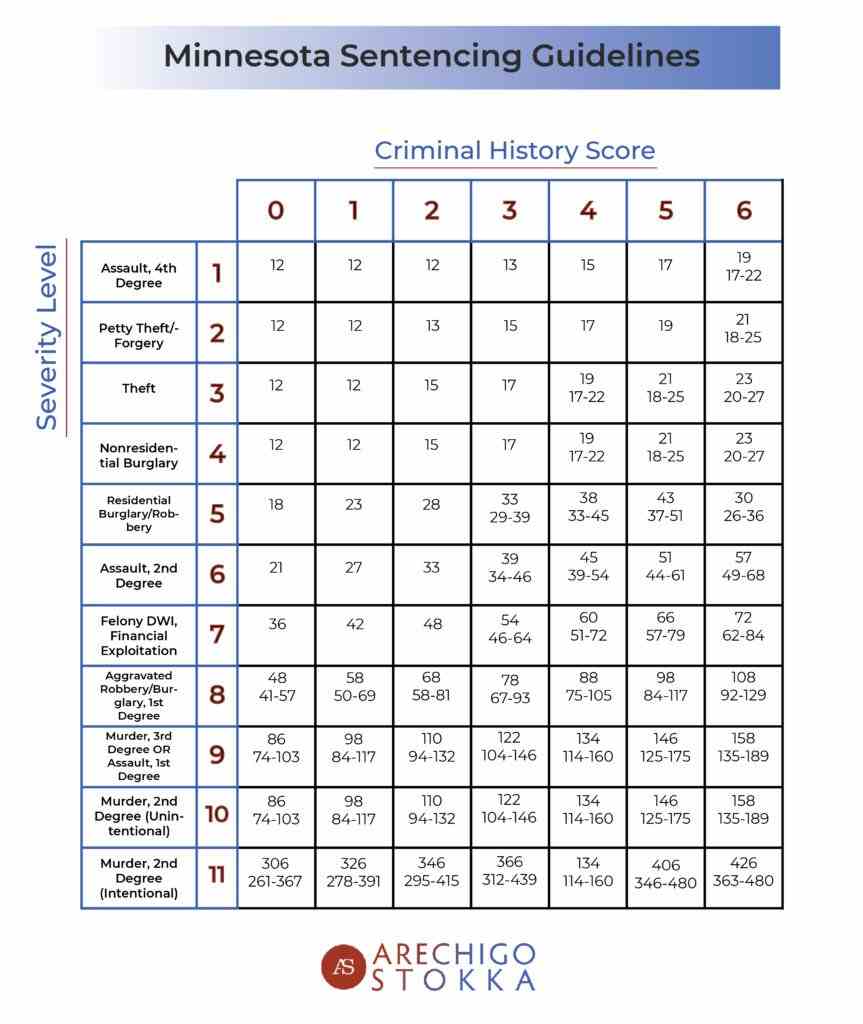
Overview of Minnesota Sentencing Guidelines
Though judges may seem to have considerable leeway in sentencing individuals who have been convicted of crimes, real-life circumstances are very different from what you see in films.
Minnesota, several other US states, and the federal government have implemented sentencing guidelines to assist judges in handing down punishment.
These sets of rules are designed to ensure fairness and consistency, so that bias doesn’t adversely affect basic principles of justice.
Like their counterparts in other jurisdictions, the Minnesota Sentencing Guidelines are extremely complex and take various factors into account in determining penalties for a conviction.
For this reason, it’s important to retain experienced legal counsel as early on in the criminal process as possible.
Your Minnesota criminal defense attorney can defend your interests in the underlying crime and will strive to obtain a favorable outcome when it comes to sentencing.
In addition, you may find it useful to review some basic information about how sentencing works under Minnesota criminal laws.
[DOWNLOAD] Minnesota Sentencing Guidelines E-Book

MINNESOTA SENTENCING GRID FAQ
Minnesota Sentencing Guidelines Chart
Below is the Minnesota sentencing guideline chart showing severity levels of crimes, the MN point system, and the felony point system in MN.

Overview of Minnesota Sentencing Commission and Guidelines
Back in 1978, Minnesota lawmakers enacted the first legislation in the US regarding a set of rules to assist judges in sentencing.
The statute created the Minnesota Sentencing Commission, a government body that implemented another first in the country:
The Minnesota sentencing guidelines went into effect in 1980. Since that time, the number of convicted felons who were sentenced according to the rules grew from 5,500 to 18,288 felony offenders in 2017 – according to the Commission’s 2019 Report to the Legislature.
The Commission is charged with establishing the Guidelines and updating them on an annual basis, with the primary goal being public safety.
A secondary objective of the sentencing system is to promote uniformity and ensure that decisions on punishment are not motivated by race, gender, or other constitutionally protected classifications.
By applying the guidelines, sentencing is more likely to be neutral, logical, and consistent.
As will be described in further detail below, the Minnesota sentencing guidelines encompass a grid system that assesses the severity of the crime and the individual’s criminal history.
The product of this analysis is a presumptive sentence, though a judge can exercise some discretion within a limited range of potential punishments.
Under designated – mostly rare – circumstances, a court can depart from the presumptive sentence.
Over the decades since the Guidelines went into effect, they have been largely successful in meeting the stated objectives of the Commission.
The 2019 Report indicates that Minnesota has consistently ranked in the top three US states with the lowest imprisonment rates; the state has earned this accolade in all but one of the 37 years spanning from 1980 – 2016.
In addition, Minnesota’s imprisonment rate in 2016 was around 190 for every 100,000 residents in the state.
This number is less than half the rate of all other states, which was 387 per 100,000 residents.
Because the system created by the Guidelines results in some of the lowest rates of incarceration, your situation may not be as grim as you think.
Of course, the outcome will depend on the specifics of your case.
A skilled criminal defense attorney can work to develop a strategy that takes the best possible advantage of the Guidelines.
SENTENCING GUIDELINES IN MN FAQ
Presumptive Versus Maximum Sentences
The Minnesota sentencing guidelines are developed around the concept of “presumptive” sentences.
The term comes from the fact that the punishment is presumed to be appropriate for all typical cases, after accounting for the individual’s criminal history and the severity of the offense for which he or she was convicted.
Within the presumptive sentence, there are two important factors:
- The presumptive duration, which is a defined sentence length as measured in months; and,
- The presumptive range of punishment, starting from a point 15 percent lower and 20 percent higher than the presumptive duration.
When applying the factors of the two-part test explained below, the judge will come to a designated spot on the sentencing guidelines grid – which contains the presumptive duration and presumptive range for individuals convicted of Minnesota felonies.
In a typical case, one that doesn’t encompass unusual circumstances, the judge will use the presumptive duration.
However, where there are factors that reflect unfavorably on the convicted individual, the court can sentence up to the presumptive range limit.
Likewise, when the person’s actions justify a reduced sentence, a judge may issue a sentence on the low end of the presumptive range.
In addition, the court is required to abide by rules related to the statutory maximum sentence.
For Minnesota felonies, the statute will usually use the phrase “imprisonment for not more than X years.”
This language defines the maximum sentence a judge can issue.
MINNESOTA SENTENCING FAQ
Two-Part Determination Under Minnesota Criminal Laws
The core of the Minnesota Sentencing Guidelines is the Grid, a table with a horizontal and vertical axis.
The axes incorporate two separate factors that a court applies when determining a sentence.
- Severity Level: Here, the focus is the crime for which you were convicted in the current case. On the vertical axis, the severity level is an assigned ranking starting on the high end at Severity Level 11 – mostly murder cases. The lowest is Severity Level 1, which incorporates certain assault felonies.
- Criminal History Score: Your past criminal record is the key consideration with this part of the test, making up the horizontal axis of the Grid. For purposes of your Criminal History Score, you accumulate points for:
- Prior felonies;
- Your custody status at the time of the offense, i.e., whether you were on probation or otherwise within the Minnesota criminal justice system;
- Prior to certain misdemeanors; and,
- Previous juvenile matters.
MINNESOTA SENTENCING GUIDELINES FAQ
Specific Rules for Certain Offenders
The standard sentencing grid applies to all felony cases except for individuals who are convicted on charges of sex or drug crimes.
Separate sentencing grids are used for drug offenses and for sex crimes; however, you’ll still accumulate points on your Criminal History Score in much the same way.
The details for these separate grids include:
- The Sex Offender Grid is divided into eight Severity Levels, by letter. The highest, Severity Level A, includes First Degree Criminal Sexual Assault. On the low end, Severity Level H applies to lesser sex crimes, such as the failure to register as a sex offender as required by law.
- The Drug Offender Grid encompasses nine Severity Levels, by the letter “D” and a number. The most severe crimes are Severity Level D9, which generally applies to high-volume manufacturing and trafficking in drugs that are listed on Schedule I of the Controlled Substances Act. Severity Level D1 is the lowest, usually involving sale or possession of limited amounts of an illegal drug.
MN SENTENCING GUIDELINES FAQ
Options Regarding Sentence Departures
According to the Minnesota Sentencing Guidelines, judges are required to stick to presumptive sentencing – either the exact presumptive duration or within the presumptive range.
However, the rules define a process through which a court may deviate from the Guidelines through “departures.”
If there’s an identifiable, compelling reason to support a departure, the sentence could be higher or lower than the presumptive range.
A departure falls completely outside the Guidelines, representing an exercise of discretion by the judge – his or her own opinion on how you should be sentenced.
An upward departure means that your sentence will be longer than the presumptive range, while a downward departure reduces your sentence.
The key is the presence of circumstances or factors involved with your criminal activity. Therefore:
- Aggravating circumstances could lead to an upward departure. Examples include crimes against vulnerable victims, large scale or widespread economic fraud, causing extreme bodily harm to the victim, or being convicted for the same crime in a subsequent case.
- Mitigating circumstances may convince a judge to issue a downward departure. For instance, your sentence may be reduced if the victim was the initial aggressor or your role in the crime was passive. Note that, in a case appearing on the Drug Offender Grid, you may receive a downward departure if you’re diagnosed with chemical dependency AND you’re willing to undergo treatment for substance abuse.
You can bring mitigating circumstances to the attention of the judge during your sentencing hearing.
On the other side of the case, the prosecuting attorney will typically argue against your position and explain to the court why the presumptive sentence should still apply.
The state may even introduce evidence of aggravating circumstances to increase the amount of incarceration.
Whenever a judge deviates from the Minnesota Sentencing Guidelines and issues an upward or downward departure, he or she must prepare a “Departure Report” regarding the situation.
Hire a Minnesota Criminal Attorney to Protect Your Rights
While this overview of the Minnesota Sentencing Guidelines may be helpful, there’s much more to the process.
To learn more about how the laws apply to your unique situation, please contact Arechigo & Stokka, P.A. to set up a no-cost consultation with an experienced criminal defense attorney.
You can call 651-222-6603 or check us out online to reach our offices in St. Paul, MN.
Our team has extensive experience representing clients throughout Minnesota and North Dakota, so we’re ready to advocate on your behalf.
[Video] Overview of MN Sentencing Guidelines
Hear From Our Past Clients
★★★★★
“They were also upfront and honest with me regarding the severity of my charges. I was informed about ALL of the possible directions that I could take in the legal system as well as the consequences and benefits what would accompany each course of action.”
Abigail P.
★★★★★
“I was so happy when John took my case, I was kept Informed of all of his every intentions, plans, and his recommendations was well thought out. My case was over in a timely manner and I felt like he was working in my best interest.”
Kiki H.
★★★★★
“I was so happy that we chose John to be our attorney! He was with us every step of the way helping us get the best outcome possible. I was very pleased with how responsive John was to our needs, even responding to my emails and texts during odd hours of the day. “
Nicole B.
★★★★★
“Very Responsive attorney , always available by phone, email, or text. Helped me Expunge a case. Best decision I ever made.”
Rae C.



